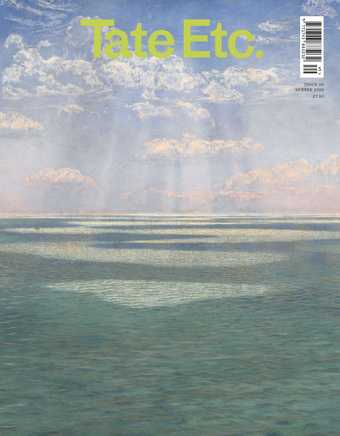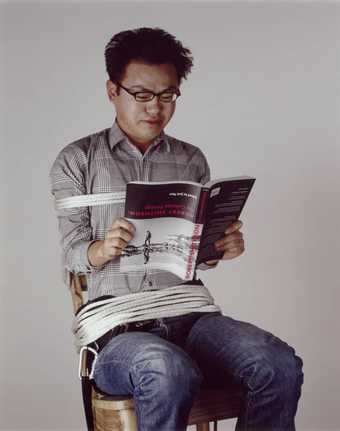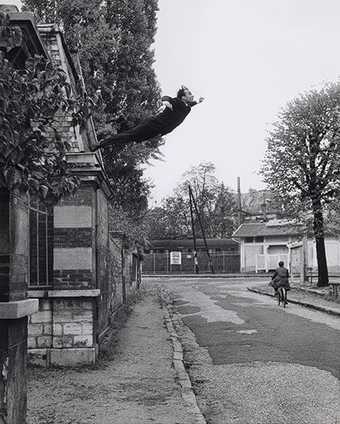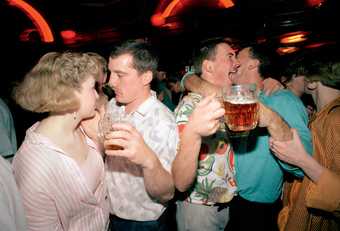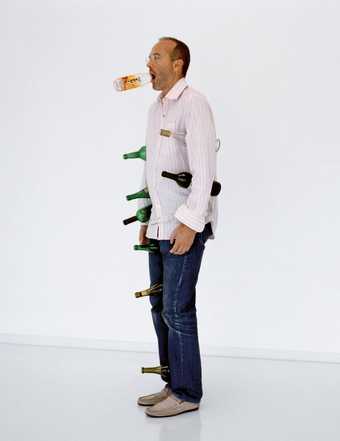
Erwin Wurm performing Nordic Sculpture 2002
© Erwin Wurm, courtesy Atelier Erwin Wurm and Galerie Thaddaeus Ropac
Since 1988, the Austrian artist Erwin Wurm (b1954) has made over 100 works with his simple idea of instructing willing people (strangers, friends or the artist himself) to try out unusual and often physically challenging interactions with everyday objects such as fruit, furniture, buckets, balls and office stationery. In one version, a participant is ordered to stuff their head and arms inside a litter bin, while in another, a volunteer is instructed to dangle their buttocks dangerously close to an arrangement of pointy pen nibs. Buckets are jauntily balanced on heads, and chair legs pressed against eye sockets.
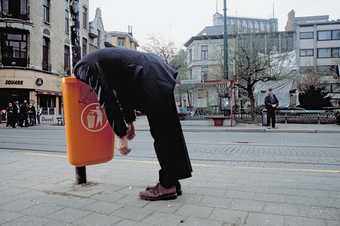
Erwin Wurm
Untitled (Trash) 2004
© Erwin Wurm, courtesy Atelier Erwin Wurm and Galerie Thaddaeus Ropac
The props in Wurm’s short-lived actions are varied enough for us to imagine the artist has rummaged through a bag of tricks minutes before the show, assembling whatever was close at hand. But under Wurm’s orders, these objects become strange, their everyday uses replaced with an alternative function. Chairs are not for sitting, they’re for balancing; boxes do not store, they conceal. Inversions like this run through Wurm’s other artworks too, for instance in his Fat Cars 2001–5 series, where sleek, swift, luxury automobiles are inflated, becoming chubby, bumbling vehicles.
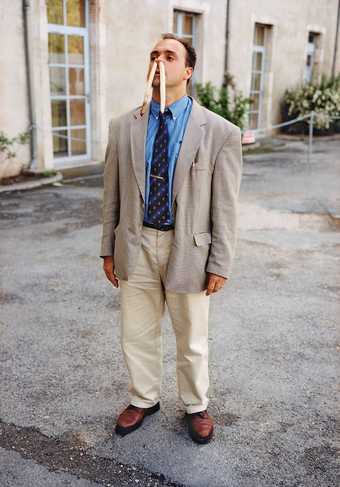
Erwin Wurm
Outdoor Sculpture Cahors (The Bank Manager in front of his Bank) 1999
© Erwin Wurm, courtesy Atelier Erwin Wurm and Galerie Thaddaeus Ropac
‘I will often use humour to seduce people,’ Wurm has said, ‘to get them to move closer, but it’s never very nice whenn they look closer.’ Sometimes people react to the artist’s instructions with laughter, sometimes with embarrassment. Stephan Berg, Director of the Kunstmuseum Bonn, has observed the effect of Wurm’s actions on the conception of one’s own body, stating: ‘The more that is poked into its orifices, and the more food and clothing that is accumulated around it, the clearer it becomes that the body and the self are no longer masters in their own house, and as a result achieve self-expression more through self-deformation.’

Erwin Wurm
Polaroid self-portrait, Untitled 2018
© Erwin Wurm, courtesy Atelier Erwin Wurm and Galerie Thaddaeus Ropac
While the One Minute Sculptures might first read as absurdist, or even a tempting boredom-busting activity for self-isolation, Wurm has explained that in the process of making the works, he began to ‘question [his] fundamental understanding of sculpture’. Thinking through mass, volume, fullness, and surface, he came to the realisation that ‘the concept of time has become the essential aspect of my One Minute Sculptures’.
Wurm has now been making his 60-second works for over three decades, but he has no plans to stop. His new project, titled Homework, will invite participants to make living sculptures from the comfort of their own homes – no doubt resulting in new, inventive uses for objects including pencils, pens and toilet paper.
A selection of photographs of Wurm’s One Minute Sculptures was presented by Georg Geyer in 2016 and purchased from the artist with funds provided by Hyundai Card in 2017.
Figgy Guyver is Editorial Assistant of Tate Etc.

